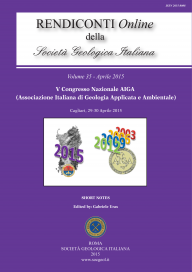
Seismic induced variation of hydraulic conductivity distribution in a large tank
Nicoló Colombani (a), Micól Mastrocicco (b) & Enzo Salemi (c)
(a) Department of Earth Sciences , Sapienza University of Rome, Piazzale Aldo Moro, 5, 00185, Rome, Italy. E-mail: nicolo.colombani@uniroma1.it
(b) Department of Physics and Earth Sciences, University of Ferrara, Via Saragat, 1 - 44122 Ferrara, Italy. E-mail: mtm@unife.it
(c) ) Department of Physics and Earth Sciences, University of Ferrara, Via Saragat, 1 - 44122 Ferrara, Italy. E-mail: enzo.salemi@unife.it
Volume: 35/2015
Pages: 78-80
Abstract
A large tank (4x8x1.4 m) equipped with 26 standard piezometers and filled with sandy sediments (35 m3), was characterized via slug tests and grain size distribution analysis in 2006. The characterization via slug tests was repeated in 2013 after the seismic events of May 2012 near Ferrara (IT) characterized by a maximum Mw of 5.9 to infer the hydrological response of the tank's hydraulic conductivity field to the stresses induced by the earthquake. Results show a general decrease in hydraulic conductivity values, due to compaction phenomena, and a variation in the spatial distribution of hydraulic conductivity values, directly correlated to the presence of the finer fraction of the sediments within the large tank. In particular, the lenses, prevalently made of sandy sediments showed a negligible reduction, while the lenses constituted prevalently by silt displayed a larger decrease. The differential hydraulic conductivity reduction inhibited the flow linkages between the sandy lenses, provoking a four times decrease in the bulk hydraulic conductivity of the tank. This laboratory experiment highlights that pronounced hydraulic conductivity shrinkages should be expected after important seismic events in heterogeneous fine alluvial units.
Keywords
Get Full Text